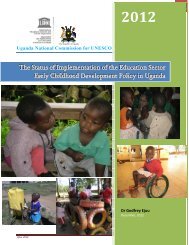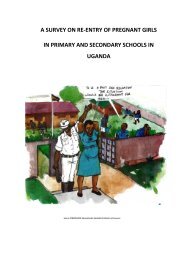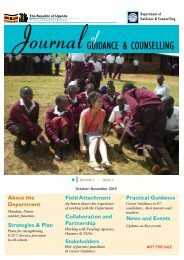Download Pdf - Ministry of Education and Sports
Download Pdf - Ministry of Education and Sports
Download Pdf - Ministry of Education and Sports
Create successful ePaper yourself
Turn your PDF publications into a flip-book with our unique Google optimized e-Paper software.
97<br />
Figure 4.28:Primary School Net Enrolment in Ug<strong>and</strong>a, 20002012<br />
120.0%<br />
100.0%<br />
80.0%<br />
NER<br />
60.0%<br />
40.0%<br />
20.0%<br />
0.0%<br />
2000 2001 2002 2003 2004 2005 2006 2007 2008 2009 2010 2011 2012 2015*<br />
Total 85.5% 86.5% 84.8% 87.4% 90.01% 93.01% 92.0% 93.3% 95% 96.1% 96% 97.5% 95.5% 100%<br />
Male 88.8% 87% 83% 87.8% 92.51% 93.62% 94.1% 95% 96.9% 97.4% 95.6% 97.1% 95.1% 100%<br />
Female 82.3% 86% 89.9% 93.7% 87.60% 92.41% 90.1% 91.4% 93.1% 94.7% 96.4% 97.9% 95.9% 100%<br />
Year<br />
Source: EMIS 20002012<br />
Figure 4.28 .shows that Ug<strong>and</strong>a’s NER hovered between 84.5%90% from 2000 to 2004. From 2004, the<br />
ratio improved gradually from 90.01%% (male 92.51%; female 87.6%) to 95.5% (male 95.1%; female<br />
95.9%) in 2012. The current sector performance gap is 4.5 percent only (male 4.9%; female 4.1%) an<br />
indication that the targeted 100% is likely to be met across gender within the remaining three years to<br />
2015.<br />
Trends in the proportion <strong>of</strong> pupils that enroll in P.1 who reach P.5 (Survival Rate to P.5)<br />
Survival rate measures the holding power <strong>and</strong> internal efficiency<strong>of</strong> an education system. It illustrates<br />
the situation regarding retention <strong>of</strong> pupils from one grade to another, <strong>and</strong> conversely the magnitude<br />
<strong>of</strong> dropout <strong>and</strong> repetition by grade. As a result, the implementation <strong>of</strong> the UPE programme <strong>and</strong><br />
Quality Enhancement Initiatives, the size <strong>of</strong> the cohorts <strong>of</strong> pupils that enroll in P.1 <strong>and</strong> successively<br />
reach P.5. Figure 4.29 summaries progress made by the sector in the last four years towards<br />
improving survival rate to P.5.<br />
Figure 4.29 Survival Rates to Grade Five (P.5)<br />
120.00%<br />
100.00%<br />
Survival Rate to P.5<br />
80.00%<br />
60.00%<br />
40.00%<br />
20.00%<br />
0.00%<br />
2001 2002 2003 2004 2005 2006 2007 2008 2009 2010 2011 2012 2015*<br />
Total 58.50% 55.25% 52% 55.7% 52% 49.5% 49% 54.1% 60.9% 60% 58% 59% 100%<br />
Male 58.90% 55.45% 52% 55.2% 52% 49.2% 49% 53.3% 60% 60% 57% 58% 100%<br />
Female 58% 54.50% 51% 56.2% 53% 49.8% 50% 54.9% 61.8% 61% 59% 60% 100%<br />
Year<br />
Source: EMIS 20012012<br />
Over the reviewed period, there was relative gradual improvement across gender in the number <strong>of</strong><br />
girls within each successive cohort <strong>of</strong> pupils that enroll in P.1 <strong>and</strong> successively reach P.5 in the last<br />
three years.<br />
ESSAPR FY 2011/12 to inform the 19 th ESSR – OCTOBER 2012








